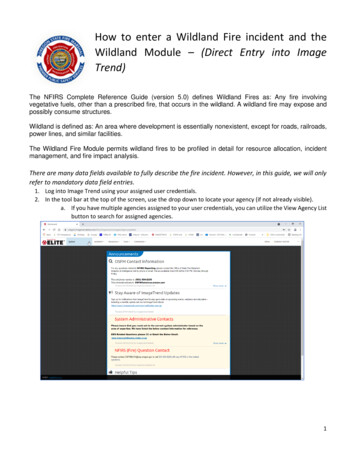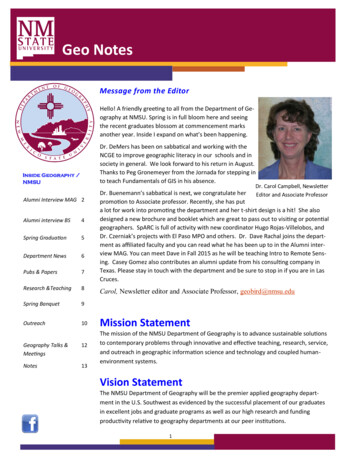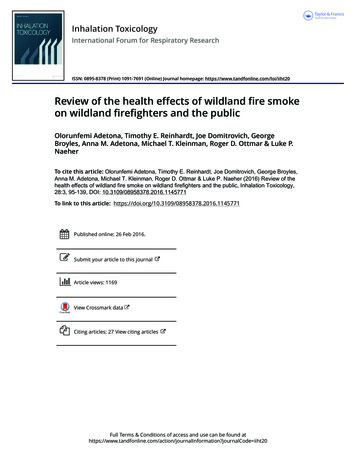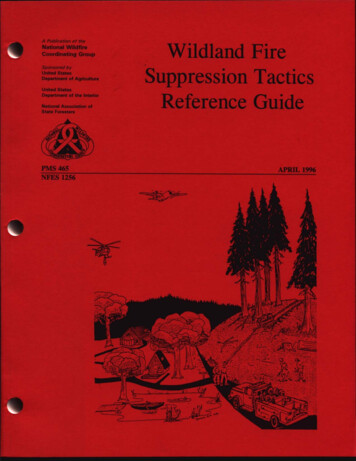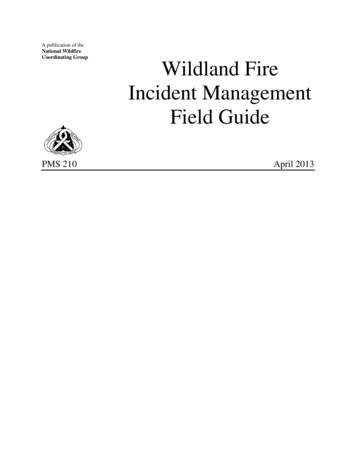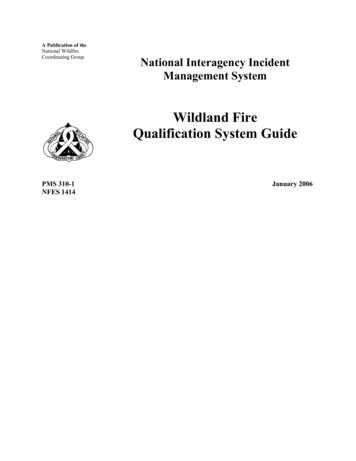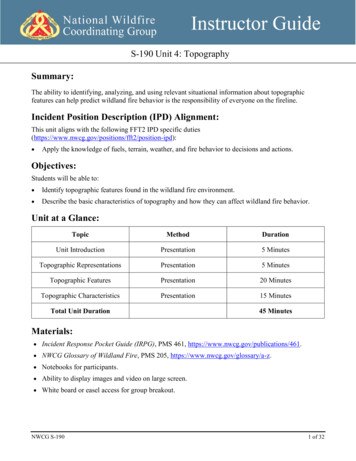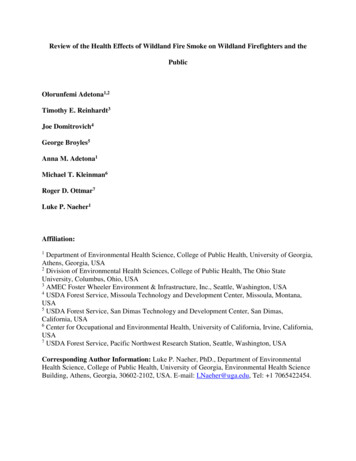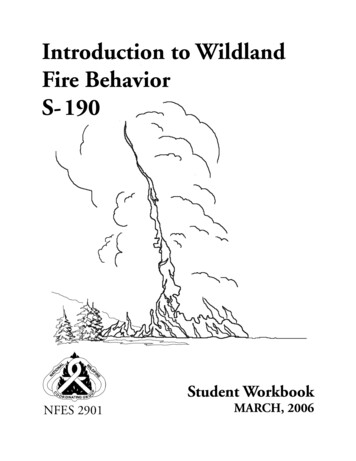
Transcription
Introduction to WildlandFire BehaviorS- 190Student WorkbookNFES 2901MARCH, 2006
Introduction to WildlandFire BehaviorS- 190Student WorkbookMARCH, 2006NFES 2901Sponsored for NWCG publication by the NWCG Training Working Team. The use of trade, firm,or corporation names in this publication is for the information and convenience of the reader anddoes not constitute an endorsement by the National Wildfire Coordinating Group of any productor service to the exclusion of others that may be suitable.Comments regarding the content of this publication should be directed to:National Interagency Fire Center, Fire Training, 3833 S. Development Ave., Boise, Idaho 83705.E-mail: nwcg standards@nifc.blm.gov.Additional copies of this publication may be ordered from National Interagency Fire Center,ATTN: Great Basin Cache Supply Office, 3833 South Development Avenue, Boise, Idaho 83705.Order NFES 2901.
PREFACEIntroduction to Wildland Fire Behavior, S-190, is identified training in the NationalWildfire Coordination Group’s (NWCG), Wildland and Prescribed FireCurriculum. This course has been developed by an interagency developmentgroup with guidance from the National Interagency Fire Center (NIFC), FireTraining Group under authority of the NWCG, with coordination and assistance ofpersonnel from the following agencies:Bureau of Land ManagementTimothy MathewsonBureau of Land ManagementChristine KeavyNational Park ServicePatrick MorganUSDA Forest ServiceMichelle EllisFire Behavior Committee LiaisonRisa Lange-NavaroNWCG Fire TrainingNoble Dunn, Deana Parrish, Sue HickmanThe NWCG appreciates the efforts of these personnel, and all those who havecontributed to the development of this training product.i
ii
CONTENTSPREFACE .iUNITS OF INSTRUCTIONUnit 0 – Introduction.0.1Unit 1 – Basic Concepts of Wildland Fire .1.1Unit 2 – Principles of Wildland Fire BehaviorLesson 2A – Topographic Influences .2A.1Lesson 2B – Fuels. 2B.1Lesson 2C – Weather . 2C.1Unit 3 – Wildland Fire Behavior and Safety .3.1iii
iv
Introduction to Wildland Fire Behavior, S-190Unit 0 – IntroductionOBJECTIVES:During this unit the instructor will:1.Introduce instructors and students.2.Discuss administrative concerns.3.Explain the purpose of the course.4.Explain the course objectives.5.Discuss expectations.6.Explain course evaluation methods.7.Explain where the course fits in the wildland fire behavior curriculum.0.1
0.2
I.INTRODUCTIONSII.ADMINISTRATIVE CONCERNSIII.PURPOSE OF COURSETo provide the student with wildland fire behavior knowledge applicable forsafe and effective fire management activities (wildfires, prescribed fire, andfire use).This course introduces students to characteristics and interactions of thewildland fire environment (fuels, weather, and topography) that affectwildland fire behavior for safety purposes.The materials in this course are elements of the wildland fire behaviorcurriculum.This is the first formal wildland fire behavior training course the studentswill receive.IV.COURSE OBJECTIVES Identify and discuss the three sides of the fire triangle. Identify the environmental factors of fuels, weather, and topographythat affect the start and spread of wildland fire. Describe the contributing factors that indicate the potential forincreased fire behavior that may compromise safety.0.3
V.EXPECTATIONSA.Student ExpectationsWhat are your expectations for the course?B.VI.Instructor Expectations Attendance at all sessions Be prepared to start on time Participate and share ideasEVALUATIONSA.Student EvaluationsStudents must obtain 70% or higher on the final exam to receive acertificate of completion for this course.B.Course EvaluationsThis is an opportunity for students to comment on the course andinstructors for the purpose of improving future courses.0.4
VII. WHERE DOES THIS COURSE FIT IN THE WILDLAND FIREBEHAVIOR CURRICULUM?A.Introduction to Wildland Fire Behavior, S-190Entry-level course designed around the basics of fuel, weather, andtopography.B.Intermediate Wildland Fire Behavior, S-290Provides a better basis for analyzing variables and understanding howthey interact and affect wildland fire behavior. Introduces the FirelineAssessment Method (FLAME); a practical fireline tool used forpredicting significant short term changes in wildland fire behavior.C.Introduction to Wildland Fire Behavior Calculations, S-390Introduces wildland fire behavior calculations by manual methodssuch as tables and nomograms.D.Advanced Wildland Fire Behavior Calculations, S-490Teaches students to use state of the art computer models to project fireperimeter growth based on weather predictions and knowledge offuels and topography.0.5
0.6
Introduction to Wildland Fire Behavior, S-190Unit 1 – Basic Concepts of Wildland FireOBJECTIVES:Upon completion of this unit, students will be able to:1.Define basic terminology used in wildland fire.2.Identify the elements of the fire triangle.3.Describe three methods of heat transfer.1.1
1.2
I.BASIC TERMINOLOGY USED IN WILDLAND FIREA.Parts of the Fire1.Point of originThe precise location where a competent ignition source cameinto contact with the material first ignited and sustainedcombustion occurred.2.Head of a fireThe side of the fire having the fastest rate of spread.3.Flank of a fireThe part of a fire’s perimeter that is roughly parallel to the maindirection of spread.4.Rear of a fire That portion of a fire spreading directly into the wind ordown slope. That portion of a fire edge opposite the head. Slowest spreading portion of a fire edge. Also calledheel of a fire.1.3
5.Fire perimeterThe entire outer edge or boundary of a fire.6.Fingers of a fireThe long narrow extensions of a fire projecting from the mainbody7.Pockets of a fireUnburned indentations in the fire edge formed by fingers orslow burning areas.8.IslandArea of unburned fuel inside the fire perimeter.9.Spot fireFire ignited outside the perimeter of the main fire by afirebrand.1.4
1.5
B.Fire Behavior Terms1.SmolderingFire burning without flame and barely spreading.2.Creeping fireFire burning with a low flame and spreading slowly.3.Running fireBehavior of a fire spreading rapidly with a well defined head.4.SpottingBehavior of a fire producing sparks or embers that are carriedby the wind and which start new fires beyond the zone of directignition by the main fire.5.TorchingThe burning of the foliage of a single tree or a small group oftrees, from the bottom up.6.Crown fireA fire that advances from top to top of trees or shrubs more orless independent of a surface fire. Crown fires are sometimesclassed as running or dependent to distinguish the degree ofindependence from the surface fire.1.6
7.Flare upAny sudden acceleration in the rate of spread or intensificationof the fire. Unlike blowup, a flare-up is of relativity shortduration and does not change existing control plans.8.FirewhirlSpinning vortex column of ascending hot air and gases risingfrom a fire and carrying aloft smoke, debris, and flame. Firewhirls range in size from less than one foot to over 500 feet indiameter. Large fire whirls have the intensity of a smalltornado.9.Backing fireThat portion of the fire with slower rates of fire spread andlower intensity, normally moving into the wind and/or downslope. Also called heel fire.10.Flaming frontThat zone of a moving fire where the combustion is primarilyflaming.Behind this flaming zone combustion is primarily glowing orinvolves the burning out of larger fuels (greater than about 3inches in diameter).Light fuels typically have a shallow flaming front, whereasheavy fuels have a deeper front.1.7
C.Other Useful Firefighting Terms1.Anchor pointAn advantageous location, usually a barrier to fire spread, fromwhich to start constructing a fireline. The anchor point is usedto minimize the chance of being flanked by the fire while theline is being constructed.2.Control lineAn inclusive term for all constructed or natural barriers andtreated fire edges used to contain a fire.3.FirelineThe part of a containment or control line that is scraped or dugto mineral soil.4.Mop-upExtinguishing or removing burning material near control lines,felling snags, and trenching logs to prevent rolling after an areahas burned, to make a fire safe, or to reduce residual smoke.5.ContainedThe status of a wildfire suppression action signifying that acontrol line has been completed around the fire, and anyassociated spot fires, which can reasonably be expected to stopthe fire's spread.1.8
6.ControlledThe completion of control line around a fire, any spot fires, andany interior islands to be saved.Burn out any unburned area adjacent to the fire side of thecontrol lines.Cool down all hot spots that are immediate threats to the controlline, until the lines can reasonably be expected to hold under theforeseeable conditions.7.ChainUnit of measure in land survey, equal to 66 feet (20 M)(80 chains equal 1 mile).Commonly used to report fire perimeters and other firelinedistances.Popular in fire management because of its convenience incalculating acreage (example: 10 square chains equal one acre).1.9
II.ELEMENTS OF THE FIRE TRIANGLEThree elements must be present and combined before combustion can occurand continue. There must be: Fuel to burn Air to supply oxygen for the flame Heat to start and continue the combustion processThese three elements or sides compose what we call the “fire triangle.”Remove any single one, and there can be no fire.III.THREE METHODS OF HEAT TRANSFERWe have learned that heat is a necessary condition for combustion, and partof the fire triangle. There are many methods by which heat can be suppliedto a fuel to start a fire. Examples: MatchesLightningCigarettesMore importantly, we must know how the fire spreads once it has started.Heat must be able to move from one burning piece to another, or the firetriangle will be broken. This movement is called heat transfer. Heat istransferred by three processes: RadiationConvectionConduction1.10
A.RadiationThink of radiant heat as a ray or wave. Radiant heat warms you asyou stand close to a campfire, or stand in the sunlight. Radiant heatcan dry surrounding fuels and sometimes ignite them.B.ConvectionThink of convection as a smoke column above the fire. Convectionoccurs when lighter warm air moves upward. The hot gases andembers which compose the smoke column can dry and ignite otherfuels.C.ConductionThink of conduction as a spoon in a hot drink. Heat is conductedfrom one fuel particle to another in the same way, through directcontact.Since wood is a poor conductor (meaning heat will not travel throughit easily), this process is the least important of the three to firebehavior.1.11
OPEN BOOK EXERCISE.1.What are the three methods of heat transfer?2.The fire triangle consists of oxygen, heat, and ?3.When is a fire controlled?4.Should you fight fire without an anchor point?Why?1.12
Introduction to Wildland Fire Behavior, S-190Unit 2 – Principles of Wildland Fire BehaviorLesson A – Topographic InfluencesOBJECTIVE:Upon completion of this lesson, students will be able to: List the basic characteristics of topography and describe how they affectwildland fire behavior.2A.1
2A.2
I.TOPOGRAPHYTopography is the configuration of the earth’s surface including its relief andthe position of its natural and man-made features.It is much easier to predict the influences which topography will have on awildfire than the influences of fuel and weather.Following are topographic terms and how they affect wildland fire behavior.A.AspectAspect is the direction a slope is facing (its exposure in relation of thesun).The aspect of a slope generally determines the amount of heating itgets from the sun; therefore, determines the amount, condition, andtype of fuels present.1.South and southwest slopes are normally more exposed tosunlight and generally have: lighter and sparser fuelshigher temperatureslower humiditylower fuel moistureThey are the most critical in terms of start and spread ofwildland fires.2A.3
2.North facing slopes have more shade which causes: heavier fuelslower temperatureshigher humidityhigher fuel moisturesA north facing aspect will have less fire activity than a southfacing slope.B.SlopeThe amount or degree of incline of a hillside (a steep slope).Fires burn more rapidly uphill than downhill. The steeper the slope,the faster the fire burns.This is because the fuels above the fire are brought into closer contactwith the upward moving flames.Convection and radiant heat help the fuel catch fire more easily.Another concern about steep slopes is the possibility of burningmaterial rolling down the hill and igniting fuel below the main fire.The position of the fire in relation to the topography is a major factorin the resulting fire behavior.A fire on level ground is primarily influenced by fuels and wind.A fire which starts near the bottom of a slope during normal upslopedaytime wind conditions will normally spread faster and has morearea to spread upslope than a fire that starts near the top of the slope.2A.4
C.Shape of the Country – TerrainCertain topographic features can influence the wind speed anddirection for small areas, independent of general weather conditionsfor an area.The shape of the country can also influence the direction of firespread, rate of spread, and the intensity.D.Box CanyonsFires starting near the base of box canyons and narrow canyons mayreact similar to a fire in a wood burning stove or fireplace.Air will be drawn in from the canyon bottom creating very strongupslope drafts. These upslope drafts create rapid fire spread up thecanyon, also referred to as the chimney affect. This affect can resultin extreme fire behavior and can be very dangerous.E.Narrow CanyonsFire in a steep narrow canyon can easily spread to fuels on theopposite side by radiation and spotting. Wind eddies and strongupslope air movement may be expected at sharp bends in canyon.F.Wide CanyonsPrevailing wind direction can be altered by the direction of thecanyon. Cross-canyon spotting of fires is not common except in highwinds. Strong differences in fire behavior will occur on north andsouth aspects.2A.5
G.RidgesFire burning along lateral ridges may change direction when theyreach a point where the ridge drops off into a canyon. This change ofdirection is caused by the flow of air in the canyon.H.SaddleWind blowing through a saddle or pass in a mountain range canincrease in speed as it passes through the constricted area and spreadsout on the downwind side with possible eddy action.I.ElevationThe height of the terrain above mean sea level, usually expressed infeet (ASL - Above Sea Level).Elevation plays a large role in determining the conditions and amountof fuel.Because of higher temperatures, fuels at lower elevations dry outearlier in the year than those at higher elevations.In extremely high elevations there may be no fuel.Elevation affects fire behavior in several other ways like the amountof precipitation received, wind exposure, and its relationship to thesurrounding terrain.2A.6
J.BarriersAny obstruction to the spread of fire, typically an area or strip lackingany flammable fuel.Barriers to fire include many things, both natural and man-made.1.Natural barriers: riverslakesrockslidesFuels which have a high moisture content do not burn as well asothers in the same area.2.Man-made barriers: roadshighwaysreservoirsfireline constructed by fire resources2A.7
OPEN BOOK EXERCISE.1.A barrier is:2.Under normal conditions, a north facing aspect will have more fire activitythan a south facing aspect.a.b.3.TrueFalseA box canyon is dangerous because:2A.8
Introduction to Wildland Fire Behavior, S-190Unit 2 – The Principles of Wildland Fire BehaviorLesson B – FuelsOBJECTIVES:Upon completion of this lesson, students will be able to:1.Identify the basic fuel types.2.Identify the fuel characteristics that influence the behavior of the fire.2B.1
2B.2
I.THE SIX BASIC FUEL TYPESA.Definition of FuelA simple definition of fuel is any burnable material. Wildland fuels are basically live and/or dead plant material. Houses, sheds, etc., can also be fuelsFuels are the source of energy that drives the fire.Regardless of the area of the country, fire behavior is dependent oncertain fuel characteristics: B.Fuel typeFuel loadingFuel availabilityFuel TypesWildland fuels are grouped into fuel types based on the primary fuelthat carries the fire. There are six major fuel types: GrassGrass – ShrubShrubTimber – UnderstoryTimber litterSlash - BlowdownFuels vary in type from one area of the country to another and withinthe same area.Differences in the amount of water in the soil is one reason that typesof fuels vary and elevation changes is another.2B.3
1.2.3.Grass Found in most areas. More dominant as a fuel in desert and range areas. Can become prevalent after a fire in timber areas. Burns hottest and fastest.Grass – Shrub Found in the plains regions and high deserts. A significant contributor to fire spread due to the finefuels mixed with the aerial/shrub fuel.Shrub Found throughout most areas. Some highly flammable shrub fuels are:–––4.Palmetto/gallberry in the southeastSagebrush in the Great BasinChaparral in the southwest and CaliforniaTimber - Understory Found throughout most areas Provides ladder to aerial crown fuels2B.4
5.6.Timber litter Most dominant in mountainous topography, especially inthe Northwest. Provides fuel for ground fire.Slash - Blowdown Debris left after natural events or human activities:–––––––– Debris may include:––––––– LoggingRoad buildingPruningThinningShrub cuttingWindFireSnowLogsChunks of woodBarkBranchesStumpsBroken understory treesShrubsProvides fuel for fire spread2B.5
EXERCISE 1.For your assigned fuel type, answer the following questions on a flip chart:1.List examples, near your area, where this fuel type occurs.2.Why is this fuel type a possible concern to firefighters?II.FUEL CHARACTERISTICS THAT INFLUENCE THE BEHAVIOR OFTHE FIREA.Fuel TypeB.Fuel LoadingThe amount of fuel present expressed quantitatively in terms ofweight of fuel per unit area (tons per acre). This may be available fuel (consumable fuel) or total fuel and isusually dry weight. The loading of the fuels in any given area does not necessarilymean the fire will burn with great intensity. What is more important is the quantity of fuels available forcombustion.2B.6
C.Fuel Availability (for combustion)Many factors are involved when talking about the availability of a fuelfor combustion.1.Fuel size classes and shapeThe physical characteristics of fuels, divided into fourcategories on the basis of their size:2.a.1-hour fuels: 0 – ¼ inch in diameterb.10-hour fuels: ¼ – 1 inch in diameterc.100-hour fuels: 1 – 3 inches in diameterd.1000-hour fuels: 3 – 8 inches in diameterSurface area to volume ratio Relates to the amount of the outer surface of the fuel thatis exposed to the air. The more surface exposed, the more easily the fuel willdry and burn. Smaller (fine) fuels have a higher surface area to volumeratio than larger (heavy) fuels.2B.7
An example to illustrate surface-area-to-volume ratio conceptsis the process of building a campfire: Start with small fuels (such as dry grass, pine needles,and small twigs), then add larger fuels (such as largertwigs and sticks), and finally add the largest fuel – thelogs.The smaller fuels (grass, needles, etc.) have a largersurface area to volume ratio than the logs, and thereforeignite more readily than the logs.D.Fuel ArrangementThe manner in which fuels are spread over a certain area.1.Horizontal continuityHorizontal continuity affects fire’s rate of spread.a.Uniform fuelsInclude all fuels distributed continuously over the area. Areas containing a network of fuels which connectwith each other to provide a continuous path for afire to spread are included in this category.2B.8
b.Patchy fuelsInclude all fuels distributed unevenly over the area, orareas of fuel with definite breaks or barriers present.Examples:2. Patches of rock outcroppings. Bare ground. Areas where another dominant type of fuel is muchless flammable.Vertical arrangementa.Ground fuelsAll combustible materials lying beneath the surface: Deep duffTree rootsRotten buried logsOther organic materialGround fire consumes the organic and combustiblematerials beneath the surface, such as a smoldering duffor peat fire.2B.9
b.Surface fuelsAll combustible materials lying on or immediately abovethe ground: Needles or leavesDuffGrassSmall dead woodDowned logsStumpsLarge limbsLow shrubsSurface fire burns surface litter, debris, small shrubs, andother vegetation.c.Ladder fuelsCombustible materials that aid the spread of fire from thesurface to the upper canopy. d.Ladder fuels can include surface litter, shrubs, andother moderate height vegetation that provides apathway from the surface to the canopy.Aerial fuelsAll green and dead materials located in the upper canopy: Tree branches and crownsSnagsHanging mossTall shrubsCrown fire burns through the tops of trees or shrubs andcan advance in conjunction with or be independent of thesurface fire.2B.10
3.Fuel moistureThe amount of water in a fuel, expressed as a percentage of theoven-dry weight of that fuel. Fuel moisture is expressed as a percent of total weight. How well a fuel will ignite and burn is dependent, to alarge extent, on its moisture content. Dry fuels will ignite and burn much more easily than thesame fuels when they are wet.– You don’t use wet wood to make a campfire!Before a wet fuel can burn, the moisture it contains mustevaporate.–This process requires more heat. As fuel moistureincreases, the amount of heat required to ignite andburn that fuel also increases. Because of their various sizes and characteristics, differentfuels in the same area will have various moisture levels. Likewise a similar type of fuel, across a broad area, willhave different moisture levels based on the amount ofprecipitation received and period of warm, dry weather.Remember, light (small) fuels take on and lose moisture fasterthan heavier (larger) fuels.4.Wet fuelsFuels that have a high moisture content because of exposure toprecipitation or high relative humidity.2B.11
5.Dry fuelsFuels that have low moisture content because of prolongedexposure to sunshine, dry winds, drought, or low relativehumidity.6.TimelagThe rate at which dead fuel gains or loses moisture.Time needed under specified conditions for a fuel particle tolose about 63 percent of the difference between its initialmoisture content and its equilibrium moisture content.If conditions remain unchanged, a fuel will reach 95 percent ofits equilibrium moisture content after four timelag periods.Firefighters use a concept of “Timelag” to identify the differentsizes of dead fuels as they relate to increasing moisture ordrying-out over time.Smaller fuels can dry out in an hour larger fuels may take ten toa thousand hours to dry.One-hour timelag fuels react to changes in relative humiditymuch faster than 100-hour timelag fuels.The timelag categories are:1-hour10-hour100-hour1000-hour0 - ¼ inch in diameter¼ - 1 inch in diameter1 - 3 inches in diameter3 - 8 inches in diameter2B.12
EXERCISE 2.Part 1View each photo and match it to the correct description.Photo #1:a. These are patchy fuels.Photo #2:b. This is a large volume of fuel.Photo #3:c. These are 1-hr timelag fuels.Photo #4:d. This is a shrub fuel type.Part 2Match the definitions to the correct descriptions.Uniform FuelsA. The amount of water in a fuel, expressed as apercentage of the oven-dry weight of that fuel.Ladder FuelsB. Grasses, leaves, pine needlesFuel TimelagC. Fuels distributed continuously over the area.Light FuelsD. All combustible materials lying on orimmediately above the ground.Fuel MoistureE. The rate at which dead fuel gains or losesmoisture.Surface FuelsF.Combustible materials that aid the spread of firefrom the surface to the upper canopy.2B.13
2B.14
Introduction to Wildland Fire Behavior, S-190Unit 2 – Principles of Wildland Fire BehaviorLesson C – WeatherOBJECTIVES:Upon completion of this lesson, students will be able to:1.Describe the effect temperature and relative humidity have on wildland firebehavior.2.Describe the effect of precipitation on wildland fire behavior.3.Describe the differences between a stable and unstable atmosphere.4.Describe general and local winds.5.Describe critical fire weather conditions.6.List the different types of fire weather forecasts and outlooks available.2C.1
2C.2
I.WEATHERShort-term variations in the atmosphere are what we call weather. Weatheris one of three components of the fire environment.Weather conditions can result in the ignition of fire by lightning fromthunderstorms and the rapid spread of fires as a result of strong winds. Onthe other hand, an increase in humidity or precipitation can slow orextinguish fires.Of the three fire environment components, weather is the most variable overtime, and at times, difficult to predict.Firefighters conducting fire suppression must monitor the weather at alltimes to make safe and effective firefighting decisions.The importance of monitoring weather and predicting the resultant firebehavior cannot be overstressed. It is one of the 10 Fire Orders and three of18 Watchout Situations that all firefighters must obey.The risk involved in fire suppression can be reduced if firefighters and firemanagers pay attention and understand weather conditions that impact firebehavior.The basic principles and concepts of fire weather as they relate to wildlandfire behavior include: Air Temperature and Relative Humidity (RH) Precipitation Atmospheric Stability Wind2C.3
II.THE EFFECT TEMPERATURE AND RELATIVE HUMIDITY HAVEON WILDLAND FIRE BEHAVIORA.Air TemperatureAir temperature is the degree of hotness or coldness of the air.1.Air temperature varies with: 2.Changes in air temperature near the surface of the earth arecaused by: 3.TimeLocationHeight above the earth’s surfaceChanging seasonsAlternations of night and dayMigrating weather systemsSeasonal and diurnal temperature changes can be large or small,depending on: LatitudeElevationTopographyProximity to the moderating influences of nearbyoceans or lakesAbrupt changes in temperatures can occur when migrating weathersystems transport colder or warmer air into a region.Heating of the earth’s surface and the atmosphere is primarily a resultof solar radiation from the sun; however, on a smaller scale, heat maybe caused by a large fire.2C.4
In the wildland fire environment, direct sunlight and hot temperaturescan preheat fuels and bring them closer to their ignition point, whereascooler temperatures have the opposite affect.Above average temperatures are common on large fires. Manyfirefighter fatalities have occurred on fires where record hightemperatures were set.Temperature is measured with a thermometer calibrated either to theFahrenheit scale or the Celsius scale.B.Relative HumidityRelative humidity is the amount of moisture in the air divided by theamount the air could hold when saturated at the same air temperature;usually expressed in percent.Relative humidity can range from 1% (very dry) to 100% (verymoist). Low relative humidity is an indicator of high fire danger.Moisture in the atmosphere, whether in the form of water vapor, clouddroplets, or precipitation, is the primary weather element that affectsfuel moisture content and the resulting flammability of wildland fuels.The amount of moisture that fuels can absorb from or release to the airdepends largely on relative humidity. Light fuels, such as grass, gainand lose moisture quickly with changes in relative humidity. Heavyfuels respond to humidity changes much more slowly.Firefighters can usually see or feel most of the elements of weathersuch as: WindRainIncreasing temperatures2C.5
Small changes in relative humidity that cannot be felt or seen can havea significant impact on wildland fire behavior.Relative humidity values for extreme wildland fire behavior vary overtime and location, and are different for different fuels types.Fuels in the southeast part of the United States and Alaska typicallyburn with considerably higher relative humidities than fuels in thewestern U.S.C.Temperature and Relative Humidity RelationshipsTemperature and relative humidity have an inverse relationship. When temperature increases, relative humidity decreases. When temperature decreases, relative humidity increases.In the early morning hours, temperature typically reaches its lowestpoint and relative humidity reaches its highest point. As the sun risesand the temperature increases, relative humidity decreases.When the temperature reaches its maximum for the day (usually midto late afternoon) relative humidity decreases to a minimum. This isthe time when fine fuel moisture reaches its minimum. As the sunsets the temperature drops and the relative humidity increases.There can be a large fluctuation of temperature and relative humidityin time and location. However, the majority of large fire outbreaksoccur when air temperature is high and relative humidity is low.It is very important for firefighters to routinely monitor temperatureand relative humidity trends. The most common field instrument usedto measure and determine these two im
The materials in this course are elements of the wildland fire behavior curriculum. This is the first formal wildland fire behavior training course the students will receive. IV. COURSE OBJECTIVES Identify and discuss the three sides of the fire triangle. Identify the environmental factors of fuels, weather, and topography


